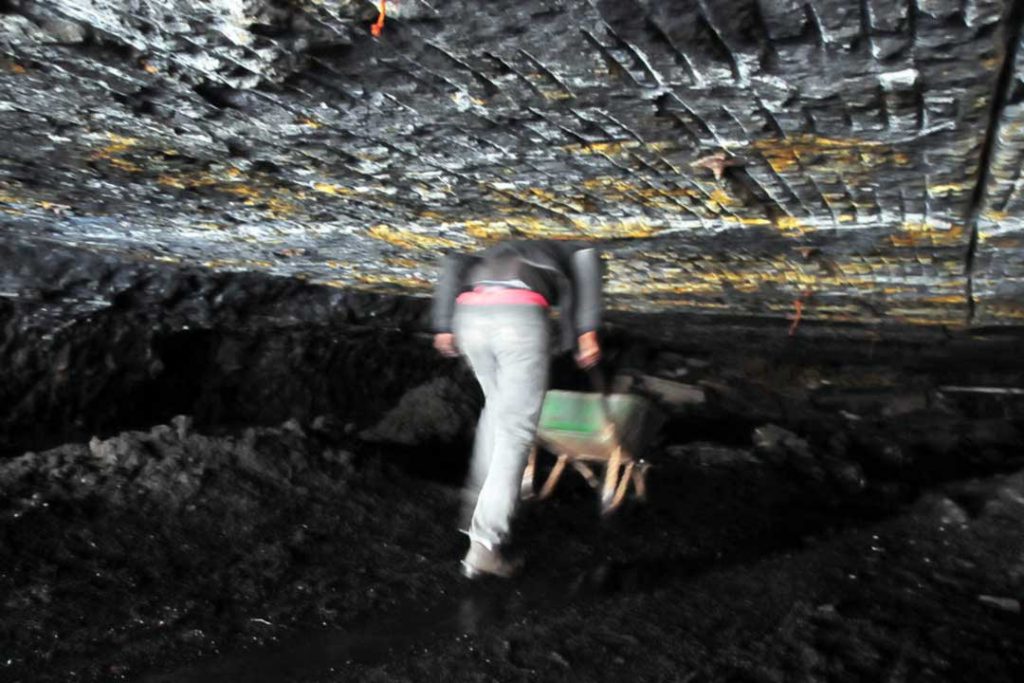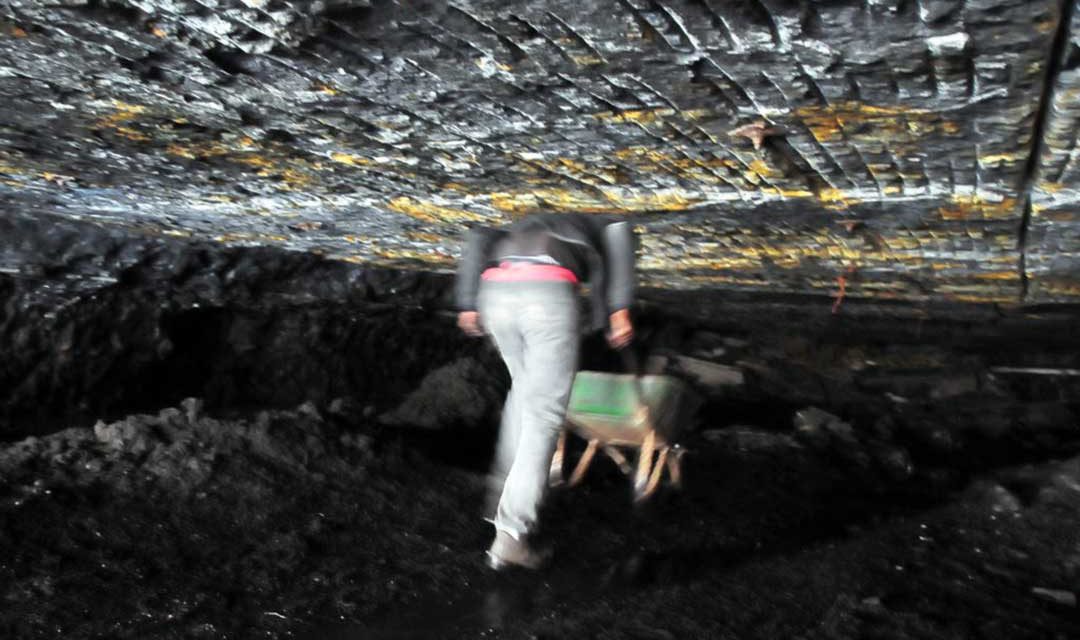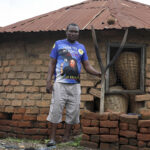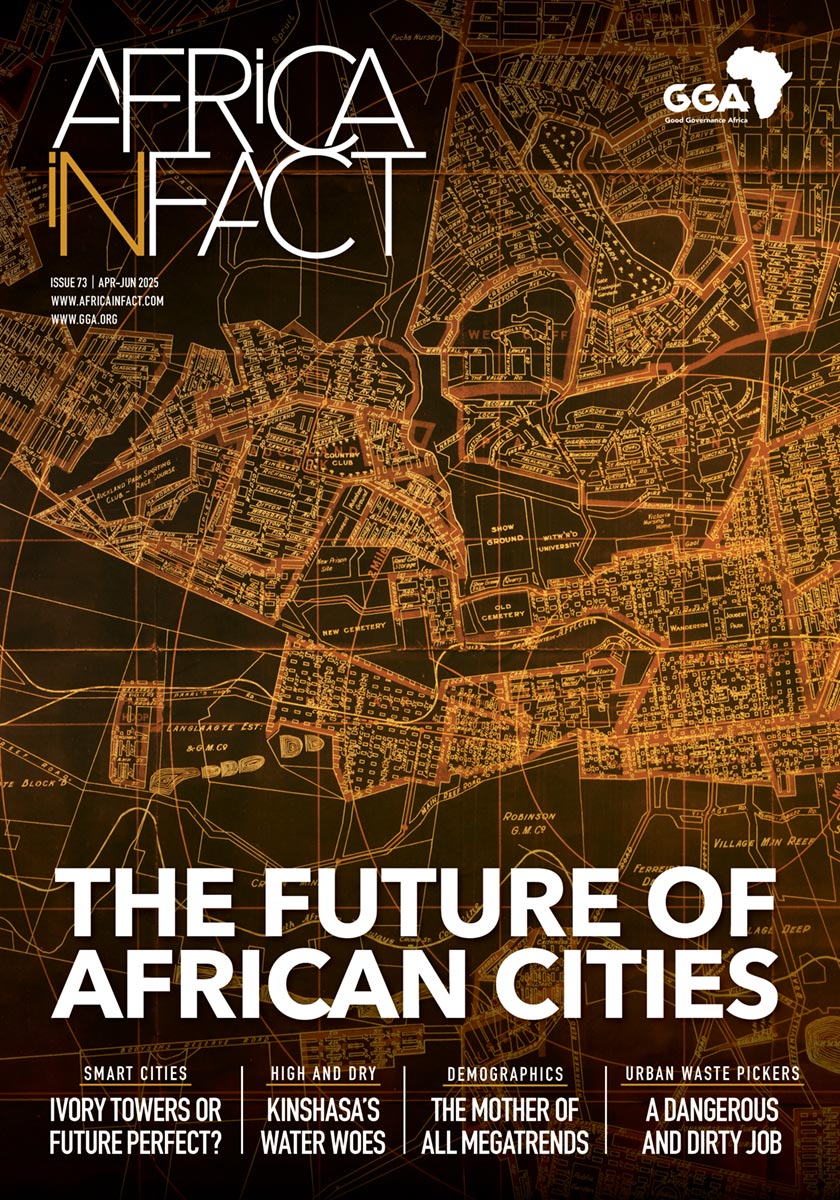
An informal miner makes his way into an abandoned mine shaft to collect coal dug with pick-axes by informal miners. Photo: © Ledwaba Mukurukuru Media
Modern laws prevent poor citizens from making a living as artisanal miners
The heavy, unmistakable stench of death hung in the air. Scores of gloomy, uneasy people stood waiting. Among them were anxious relatives, wives, girlfriends, brothers and parents. In the corners of the vast complex of the Welkom police station lurked shady men who kept to themselves. Among them was a man who identified himself as Lehlohonolo from Lesotho, one among many who eked out a dangerous living mining for gold in old disused shafts. He was a zama-zama, slang for artisanal or illegal miners in South Africa.
He had come to search for missing colleagues among the dead. His neat, gentlemanly appearance defied the public image of zama-zamas as ragged, gun-toting men ready to kill at the slightest excuse. It was June 2009. In the little morgue in the grounds of the Welkom police station, the rotting bodies of some 87 men – zama-zamas killed in a gas explosion in one of the old gold mine shafts – lay packed one on top of the other. The bodies had been discovered in the Eland shaft owned by Harmony Gold Mining Company Ltd in the Free State town. The groups of people waiting in the grounds of the police station were there to identify missing relatives among the dead. Yet, none of them would concede that their relatives were zama-zamas.
Instead, they would only say they were there to enquire about the fate of missing loved ones; they wouldn’t say why they suspected their loved ones might be among the dead. Such was the secrecy around their activity that those doing it wouldn’t publicly acknowledge it, and those who benefited from it would deny knowing how their loved ones earned a living.
Although zama-zamas had been known to be operating in the gold fields of the Free State, Gauteng and Mpumalanga for many years, this was perhaps the first high-profile case in which many had been killed at once. Since then, more than 600 zama-zamas have been killed in rockfalls, gas explosions and inter-gang wars, both underground and on the surface, in Gauteng, Free State and Mpumalanga.
The numbers could be even higher. It is almost impossible to find reliable statistics about zama-zamas due to dangerous conditions underground and the clandestine nature of their operations. Yet, the daily risk of death and injury has not deterred these artisanal miners from going underground. While violent gang wars have created a negative and menacing image of zama-zamas, in reality many of them are simple men and women who just want to make a living in an activity that is considered illegal under South African law and, therefore, unregulated. This has led zama-zamas to become a law unto themselves, operating in an industry where they live by their own rules.
Statistics South Africa put SA’s unemployment rate in the first quarter of 2017 at 27.7%, the highest since September 2003. Meanwhile, the Mineral and Petroleum Resources Development Act 28 of 2002 (MPRDA) is in force, prohibiting the activities of zama-zamas, who mine without the required permits. But the law has not stopped hungry people from daily risking their lives underground.
The hardest hit are young people like Sibusiso, a 23-year-old zama-zama I met in July 2017 in Ermelo, an industrial town in South Africa’s Mpumalanga province. He is one of scores of men and women who toil daily at an abandoned coal mine, Golfview, near Ermelo.
There, men and women dig for coal or load it, working 12 hours a day and earning between R450 and R1,200 per shift. The coal is then loaded onto bakkies (light-delivery vehicles) belonging to traders, who resell it in communities around Ermelo.
Sibusiso says he matriculated four years ago while living in an informal settlement near Secunda, a coal-mining town in Mpumalanga. Now the father of two young children aged three and 18 months, he struggled to find money to pursue his studies or to find a job. An acquaintance told him about the zama-zamas working at Golfview mine. To feed his children, he had to choose between crime and taking a chance as a zama-zama. He chose to make a living the same way his ancestors did in the region thousands of years ago.
The Ngwenya Mine in Swaziland, just a little over 200 km from Ermelo, is on the tentative list of World Heritage sites operated by the UN Educational and Scientific Organization (Unesco). Evidence suggests the mine dates back some 43,000 years, and southern Africa may have been at the forefront of early iron mining and smelting, as early as 400 BC. Further historical evidence points to precious-metal mining in or around Mapungubwe in about 1200 AD. By the time European settlers “discovered” gold and began mining it for industrial use in the late 1880s, Africans had already been mining for over 40,000 years. There is also historical evidence of mining in other places in South Africa around that time, particularly for iron, gold and other minerals.
It could be argued that informal mining pre-dates formalised industrial mining as we know it today, and that zama-zamas, just like subsistence farmers in South Africa’s rural villages and townships, are simply continuing a culture that has existed for many thousands of years. Africans were mining at places such as Ngwenya, Mapungubwe and Phalaborwa well before the advent of mining companies such as De Beers, and before the existence of institutions such as the Chamber of Mines and the department of mineral resources. Yet the laws of the country have effectively criminalised their activity. Unlike people who live off the land through farming, zama-zamas find themselves making a living in a highly regulated and lucrative sector, which makes them a target for the authorities and the mining companies.
In the platinum- and chrome-rich Sekhukhune district in Limpopo, zama-zamas, using earth-moving equipment and other sophisticated tools, openly mine the minerals underneath the mountainous terrain. Contrary to the armed and dangerous gangs operating in the deadly gold fields of Gauteng and Free State, these are family men and women with homes in and around the villages where they mine without permits. Some previously worked on mines that extract minerals from their homeland, but give back little in return.
“Did God put us next to this chrome belt by mistake?” asked Kgaogelo Mapoulo, who makes a living as a zama-zama mining chrome, during a meeting in June 2017, between Deputy Minister of Mineral Resources Godfrey Olifant and zama-zamas in Burgersfort. “We cannot just be caretakers of the minerals in our own land.” Articulate and literate, and the opposite of the rag-tag popular public image of a zama-zama, Mapoulo said he was a good-standing member of the ANC. Olifant, meanwhile, was there in a bid to quell the rising anger that had led to violent public protests after police and mine security personnel confiscated equipment from zama-zamas and arrested a number of people in a crackdown on their activities.
Unofficial estimates put the number of people who benefit from zama- zama activity in the Sekhukhune area at more than 10,000, which includes the families who are supported by income from this business. The feeling among the Sekhukhune zama-zamas is that their activities are in line with the ANC’s declaration in the Freedom Charter that the mineral wealth of the country shall be restored to the people. Now, they want Olifant and his department to issue them with mining permits. However, Olifant has indicated this won’t be happening anytime soon. Zama-zamas, he said, needed to conform to health and safety regulations. But health and safety regulations are stringent, which would place zama-zamas in a difficult position.
In September 2017 protests broke out around Kimberley’s diamond fields when police and mine security personnel cracked down on thousands of zama- zamas who salvage the crumbs left over by mining giant De Beers during the more than a century it has operated there. A month earlier, an NGO, Mining and Affected Communities United in Action (MACUA), wrote to the government demanding that zama-zamas be decriminalised. MACUA described the crackdown on zama-zamas as “a fight between the needy and the greedy”. It remains unlikely, however, that there will be any change in legislation.
In the memorandum MACUA argued that the Mineral and Petroleum Resources Development Act is in direct contravention of the UN’s International Covenant on Economic, Social and Cultural Rights, to which South Africa is a signatory. By failing to legalise zama-zamas, they argued, the government is effectively violating people’s right to work, which is recognised in the UN covenant and the South African constitution.
MACUA wants the department of mineral resources to call an urgent conference on the zama-zama phenomenon, at which representatives of the government, communities, zama-zamas, corporates, academics and civil society will discuss possible solutions. However, the Chamber of Mines has called for stricter measures against zama-zamas, complaining that when caught they are often only charged with trespassing, which incurs a small fine.
The chamber, which regards zama-zamas as nothing less than criminals who steal from its members, has called for more “proactive measures” and harsher penalties against them. Proactive measures would include working with the department of justice to persuade prosecutors to apply laws carrying stricter penalties, rather than merely charging suspects with trespass. The stricter legislation would include, among others, offences under the Criminal Procedure Act (1977), the Hazardous Substances Act (1973) and legislation covering explosives.
In April 2017, Sibanye Gold, a South African gold mining company, announced a R200-million plan for a so-called “zero zama” initiative, aimed at bringing zama-zama operations to a halt. While this may sound like a step in the right direction, it is highly unlikely it will yield any positive results. Most zama-zamas are hungry people making a living as their ancestors did. And as the saying goes, a hungry stomach knows no boundaries.
Lucas Ledwaba is the founder and editor of Mukurukuru Media, an agency specialising in feature articles and photographs. He is the author of Broke and Broken, The Shameful Legacy of Gold Mining in South Africa (2016) and co-author of We Are Going to Kill Each Other Today – The Marikana Story (2013). His work has appeared in the Mail & Guardian, the Sunday Times, City Press, Destiny magazine, Drum magazine and the African Times, among others. He has won several prestigious prizes for his feature writing, and his photographic work has been exhibited locally and in the USA.














